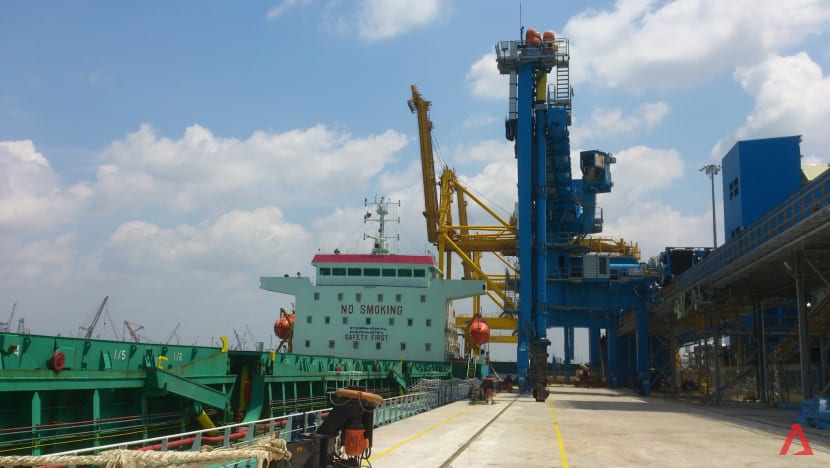From 1.2% to zero: What will it take to phase out coal from Singapore's energy mix?

File photo of the Tembusu Multi-Utilities Complex on Jurong Island.
SINGAPORE: Even though coal makes up just over 1 per cent of Singapore's energy needs, phasing out the use of the fossil fuel may not be such a straightforward affair for Singapore, experts say.
On Nov 4, Minister for Sustainability and the Environment Grace Fu announced that Singapore has joined the Powering Past Coal Alliance, an international coalition of 137 governments and businesses promoting the transition from coal to clean energy.
This was announced at the 26th United Nations Climate Change conference, otherwise known as COP26, held in Glasgow, Scotland earlier this month.
Singapore’s membership in the alliance requires that it phases out its own use of “unabated” coal power – referring to the burning of coal without the use of technology to capture carbon emissions – by 2050, as well as ends direct government financing of such unabated coal power internationally.
On coal financing, the three major local banks – DBS, UOB and OCBC – have pledged not to finance any new coal-fired power plants. In addition, DBS has announced a commitment to phase out thermal coal exposure, which includes coal mining.
Coal is often described as the “dirtiest” fossil fuel, producing twice as much carbon dioxide compared to natural gas and responsible for 46 per cent of global carbon emissions, according to the International Energy Agency.
Given the almost three-decade headstart, observers say Singapore may well be able to meet the first goal far ahead of the 2050 deadline.
More than 95 per cent of Singapore’s electricity demands are met by natural gas, with coal making up just 1.2 per cent of the country’s energy needs.
Singapore’s only coal-burning utility plant is the Tembusu Multi-Utilities Complex on Jurong Island, which supplies steam and electricity to chemical companies on the industrial island.
Officially opened in 2013 at a cost of S$2 billion, the complex – which burns low-sulphur coal as well as other materials such as wood chips and natural gas – is operated by Tuas Power, which has been owned by Chinese firm Huaneng Power International since 2008.

Speaking in Parliament in 2013, then-Second Minister for Trade and Industry S Iswaran said only “low ash and low sulphur” coal would be used, with biomass mixed with coal to lower the complex’s greenhouse gas emissions to below that of an equivalent fuel plant.
Mr Iswaran said then that the complex had to meet “stringent requirements” for pollutants such as particulate matter and mercury. It also had to meet environmental standards as stipulated under the Environmental Protection and Management Act and its Regulations.
PHASING OUT COAL
“From a national level supply and demand perspective and considering current excess generation capacity, Singapore can phase out the use of coal before 2050,” said Dr Victor Nian, founding member, council member and honorary general secretary of the International Society for Energy Transition Studies.
“However, with coal capturing the major proportion of the fuel supply to the complex, such action means the complex would either source for additional biomass supply or shut down the generation units before its end of service life,” he added.
Singapore Management University (SMU) climate scientist Winston Chow said there is no reason why Singapore can't phase out coal ahead of 2050, but noted that the 150 workers employed at the plant need to be retrained for other jobs.
He also pointed to Singapore’s intention to explore carbon capture technology – referring to the process of capturing and either storing or recycling carbon dioxide – and said he “wouldn’t be surprised” if the Jurong Island plant was utilised for such purposes, together with other oil-fired and natural gas plants.
“From a technical standpoint, carbon capture, coal-to-liquid and coal-to-gas are all potential options to reduce the environmental impact of coal use,” said Dr Nian, though he noted these could be costly.
Associate Professor Chow said the technology already exists on a small scale to capture and convert carbon from fossil fuels to other uses.
He noted however that there are issues with the economics of both conversion and utilisation of carbon in such a way, as well as storing and sequestering it away from the atmosphere.
Such options would need to be deployed at an industrial scale to justify their cost, said Dr Nian.
“Given the various constraints facing Singapore and the present power market situation, phasing out coal is a more practical approach to decarbonisation,” he said.
Even so, this could lead to the Tembusu Multi-Utilities Complex becoming a “stranded asset”, he said, since a typical coal-fired power plant has a lifespan of between 40 and 50 years.
“Since there are not enough domestic biomass resources and (given) the lower heating value of biomass compared to coal, moving towards 100 per cent biomass, instead of shutting down the plant, can hinder cost competitiveness in the power market,” said Dr Nian.
CARBON CAPTURE, UTILISATION AND STORAGE
At the end of COP26 on Saturday (Nov 13), almost 200 countries came together in a pact to combat climate change.
Mr Prakash Sharma, Asia-Pacific head of markets and transitions at energy research consultancy Wood Mackenzie, noted that countries such as China and India had insisted that the wording of the final text be amended to “phase down” rather than “phase out” coal-fired power.
“Last minute changes reflect current realities of individual energy markets where countries aim to prioritise supply security over environmental goals, at least through the medium term until other clean baseload supply options are commercially available at the scale that’s needed to replace coal in power generation,” he said.
Short of eliminating fossil fuels entirely, employing carbon capture, utilisation and storage technology may well be the most environmentally friendly option for Singapore moving forward.
“The most ideal carbon-friendly way is not to extract and burn fossil fuels at all, but in several contexts where there is energy scarcity and renewable energy can’t be easily upscaled, applying CCUS (carbon capture, utilisation and storage) is one of the ways to address these issues,” said SMU's Assoc Prof Chow.

















